How To Draw The Human Face How To Draw The Human Eye
I've resisted writing this kind of postal service for a long time. In my experience, the type of instructional content constitute in countless books, blogs and YouTube videos with titles like How To Draw '10' is usually oversimplified and misleading.
There are ii reasons for this. First, when you draw a portrait, things like the model's individual morphology, our perspective as the viewer, and the lighting environment are different in every case, and tin can profoundly affect your decisions. Drawing well is ordinarily more complicated than just following a list of formulaic steps that don't take variables into account.
Second, thinking in terms of "how to draw eyes" – equally if the optics are somehow privileged and separate from the residue of the face, head and body – breaks upwards the figure into artificial categories. In truth, there's as much structure to be observed on the model's cheek or forehead as in the eyes, but we tend to be unaware of that (in that location aren't many "How to Describe Foreheads" tutorials out there). Instead, we focus on "eyes", "nose" and "mouth" too much, and forget about everything else. Articles like this make me queasy because they seem to reinforce this way of thinking.
Withal, drawing disarming eyes is something a lot of students struggle with, ofttimes unnecessarily. We tend to approach the eyes in our drawings with lots of feet because they're psychologically important to homo beings. It's too where we look showtime in a portrait. Mess up the eyes, and you're suddenly stuck with a "bad drawing", while the aforementioned degree of error in describing the cervix or chin may become unnoticed by most viewers. Information technology's not fair, but it's the way it is.
In this mail, I'll lay out the things I call back about nigh when drawing eyes on a portrait. I'll try to take some variables into business relationship, but call back these instructions are non universal. There volition be plenty of times while drawing a model when you'll see problems non mentioned here. But that'south what learning to draw portraits is similar. As like as human beings are to one another, there's all the same no one-size-fits-all education set for drawing optics – or anything else. The manner forward is to absorb what you can from teachers you trust, but exist prepared to adapt and improvise as you encounter unique problems… because y'all will.
So, permit's get started.
Big Things Beginning
This is proficient advice for drawing any subject area, not just optics, because it'south easy to become bogged down in details when drawing something complicated. Eyelashes, wrinkles and subtle highlights are all fun to draw, but are nothing but distractions early on (ones I still succumb to from time to time). As students who've taken online courses at Vitruvian Studio already know, it's always advisable to work from "general" to "specific" while cartoon. In other words, establish the biggest, broadest shapes first, and then subdivide them to arrive at the smaller, more than specific characteristics.
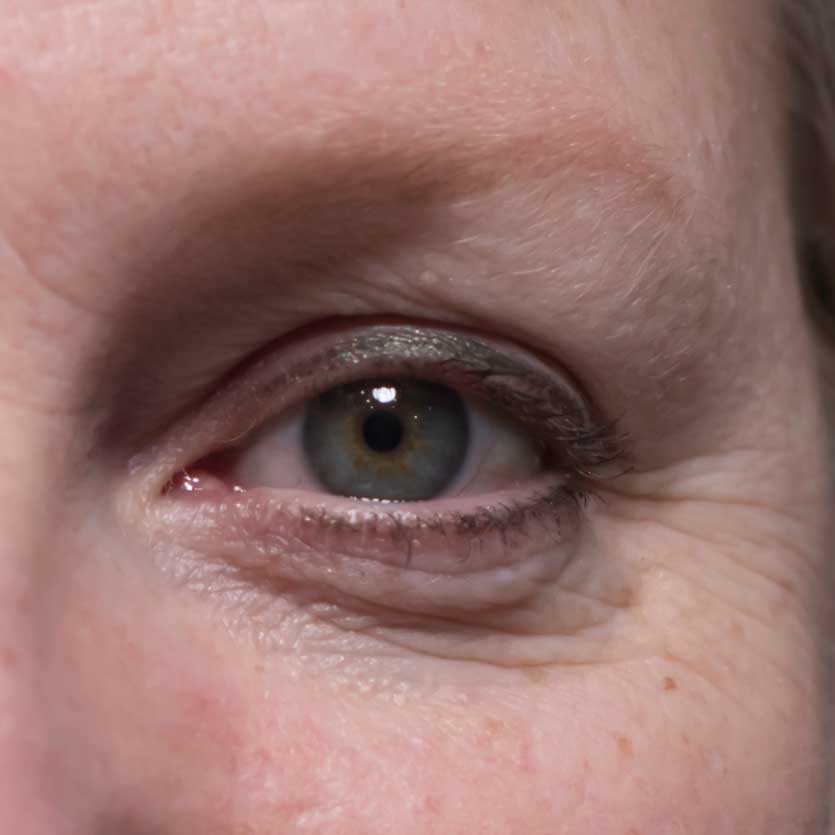
Context is Of import
You lot don't have to be a comedian to know that when telling a joke, you tin can't just leap to the punchline. Y'all have to "set it upwards" first. If y'all don't, even the funniest joke in the earth won't quite work.
The same principle applies to drawing.
The biggest problem with most "how to draw eyes" tutorials is that they jump also chop-chop to cartoon… well… eyes – the eyelids, iris, student, etc – without first setting-up a structural context for the eye. In other words, optics look the fashion they do in part because of everything that surrounds them.
This means that we need to look beyond the boundaries of the eye itself to consider the broader center region, including the bony structures of the brow and brow, the cheekbones, and the nose.
1: Build the Eye Socket
The eyeball is gear up deep inside a crenel in the skull called the "orbit" – or more commonly, the "eye socket". Each heart socket on the skull is bordered visually by 3 bones:
- The Frontal Os across the top, forming what's called the "brow ridge"
- The Maxilla forth the inside (medial) edge and the lower medial corner
- The Zygomatic Bones, or cheek bones, along the outside (lateral) edge and lower lateral corner
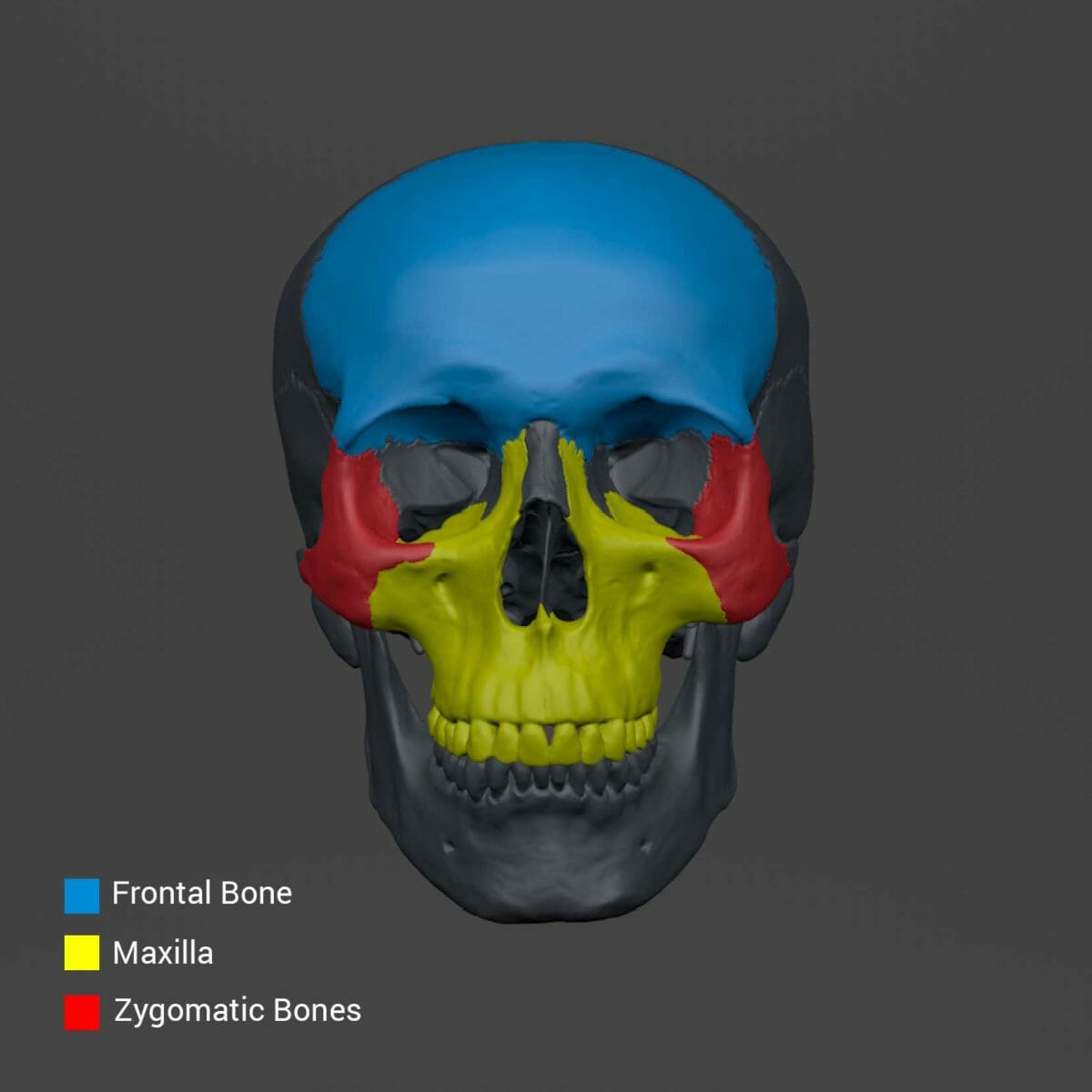
(In the forepart view, the nasal bones may announced to border the center socket, but they're really set quite far forrad of the orbital cavity, so I haven't listed them here.)
These iii bones are what give the eye socket its characteristic shape, which in the front view isn't actually round, but more of a rhombus with rounded corners.
Starting with an HB pencil, lightly marking the boundaries of the eye socket on the page. Looking for certain landmarks will assist you practice this:
- The eyebrow: While it doesn't mark the top of the socket (that sits lower), the eyebrow is useful considering it's oftentimes easy to run into and it marks a aeroplane change where the brow ridge begins to plough down and in toward the eye socket.
- The supraorbital margin: this is the actual top border of the socket itself, and is often marked by a deep crease at the pinnacle of the upper lid, where it folds on itself every bit it rolls up and under the brow ridge, similar a retractable awning. This sharp definition is sometimes seen down the lateral side as well, along the upper part of the zygomatic bone. (Due to the centre cover fold, this crease isn't visible on individuals of asian descent.)
- The inner canthus, or "tear duct" at the within corner of the eye, marks the medial (or inside) border of the eye socket.
- The infraorbital furrow marks the lesser boundary of the socket, and is ofttimes seen on the surface as a soft ridge running downward and laterally from the inside corner of the eye. Its trajectory echoes that of the brow ridge above it.
Go on it lite! These lines are merely placeholders that you'll likely desire to remove later. Don't blast them in! Draw lightly with the shoulder of the pencil atomic number 82 to avert gouging your newspaper.
2: Block-in the Shape and Position of the Eyelids
When blocking-in the eyelids, remember that they're stretched effectually the eyeball beneath them, which largely determines their shape. The trajectories of the lids as they arc across the eyeball are essentially cross-contours on a sphere – similar lines of latitude on a globe. On the eye, these trajectories aren't perfectly elliptical because they get pushed around by the cornea on the eyeball and the bony structures of the socket. Nevertheless, the eyeball is basically round, and that roundness is the biggest influence on the shape and path of the eyelids as they arc from corner to corner.
The dainty thing about building the middle socket starting time is that it helps u.s. find the outer boundaries of the lids:
- The top of the upper lid is divers by the top of the middle socket – the "supraorbital margin" – and follows its downward-lateral trajectory.
- The bottom of the lower hat sits just higher up the infraorbital furrow at the bottom of the eye socket, and also echoes its down-lateral trajectory.
- The inside corner of the centre sits directly on the within edge of the center socket. We merely demand to determine how loftier or low it sits.
- The lateral corner of the eye is coincident with the supraorbital margin laterally every bit information technology turns down toward the zygomatic bone.
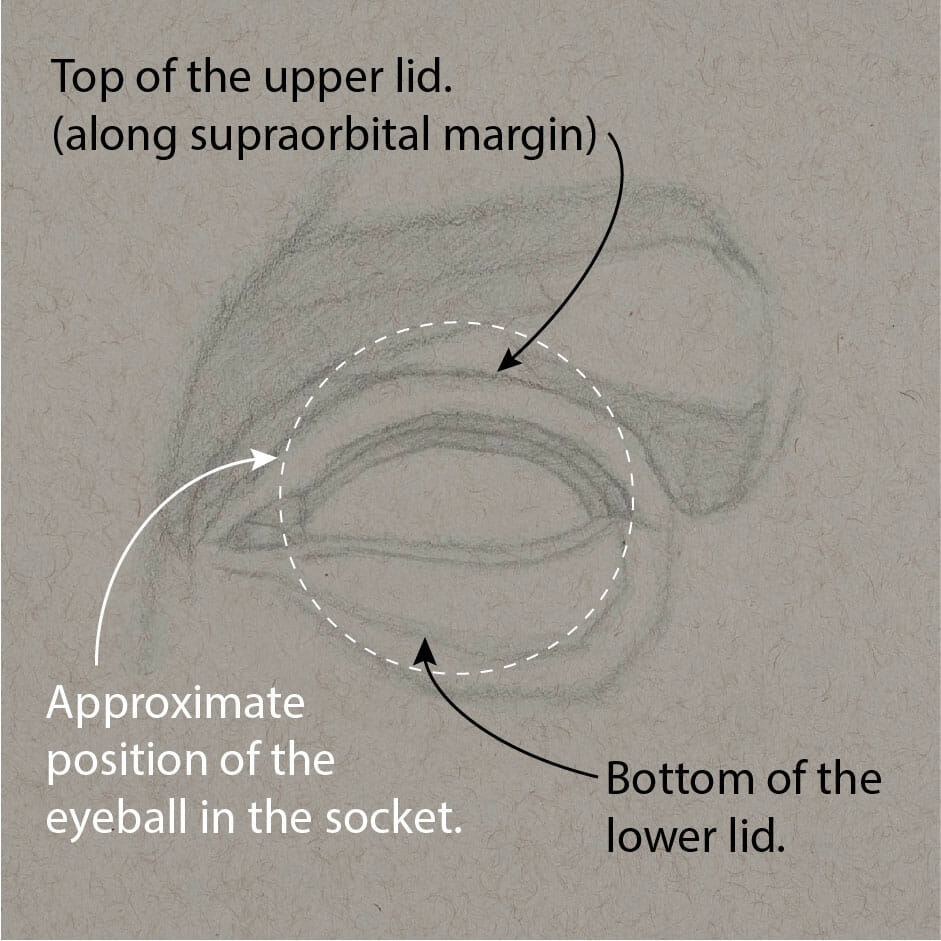
At this signal it may exist noticeable that the eyeball sits surprisingly high within the heart socket, being tucked upwards and under the top of the supraorbital margin.
Notation:
You may be wondering why I don't suggest drawing the eyeball at this stage. Some tutorials advocate this, and it makes a certain amount of sense. After all, the eyeball fills much of the eye socket we just finished establishing, and is responsible for much of what we perceive as the shape of the center, so its influence is important.
I don't suggest we draw the eyeball directly, however, because we come across so little of it. Existence mostly covered past the brow ridge and eyelids, the precise size and position of the eyeball in the socket tin can be ambiguous at best. The tendency is to describe the eyeball either too large or as well pocket-sized, and too low in the socket, which tin can create problems for u.s. downward the road.
Instead, let's continue past blocking in the parts of the heart nosotros tin actually run across (either directly or through their influence), starting with the larger, containing shapes. At this stage, with the eye socket already established, that means drawing the eyelids.
The Orientation of the Eye
It's piece of cake to assume that the eye, from corner to corner, sits horizontally on the head, but that's oft not the case. Usually, one of the two corners of the eye sits slightly higher than the other.
This can vary between individuals and with your angle of view on the model, only information technology'due south ever worth checking. Imagine a straight line connecting the two corners of the center and determine its tilt. And so try to replicate that angle on the page as carefully as you can.
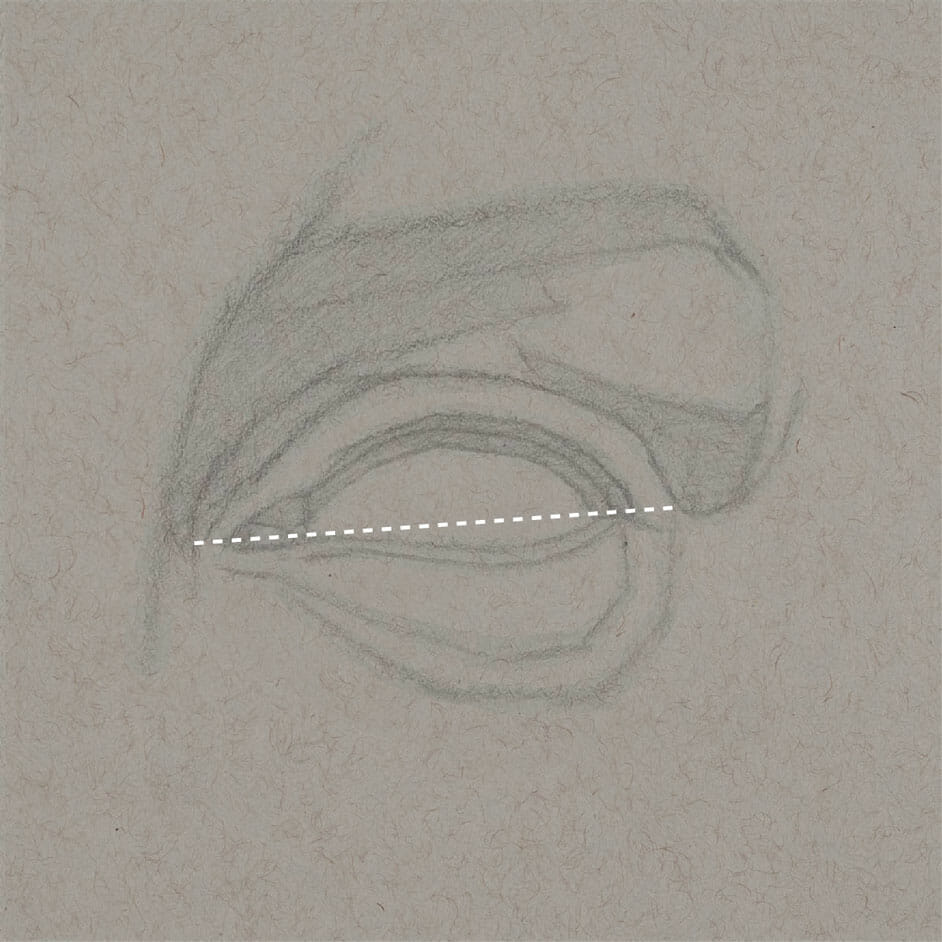
About the Shape of Eyelids
The eyes are not shaped like footballs or almonds. And yet, this is one of the most common mistakes made by students – and for that matter, many "how to draw eyes" tutorials.
While it's true that the opening between the lids tapers to a bespeak on each side, that shape is too asymmetrical.
The Outer Boundaries:
Look for the "loftier point" – or apex – of the curve of the upper lid and yous'll find it sits somewhat medially (or toward the within). This is because the course of the lid follows the path of the supraorbital margin, which is angled downward, laterally.
The Inner Boundaries:
The outer and inner boundary of each eyelid repeat one some other, just they aren't parallel. The inner boundaries appear less curved when the eyes are open up because of perspective – they aren't rolled up or downwards over the eyeball as much as the outer boundaries, which makes the curvature appear less amplified from our angle of view.
It's also of import to note that in conventional portraiture, with a more than-or-less eye-level view on the model, the upper lid often appears more than rounded and the lower chapeau "flatter" (this isn't always the case, but it happens frequently enough to be worth mentioning). The reason for this is simple. When the centre opens, the upper chapeau does most of the work, rolling upwardly and over the eyeball, like an canopy. The lower chapeau stays relatively stationary. This means that the upper hat sits up on top of the eye when it is open up, arcing up-and-over the round form of the eyeball, and thus actualization more rounded from our bespeak of view. The lower lid, past comparing, doesn't "roll down" very much, but rather pulls relatively direct across, actualization less curved from our signal of view.
The Eyelids Have Thickness
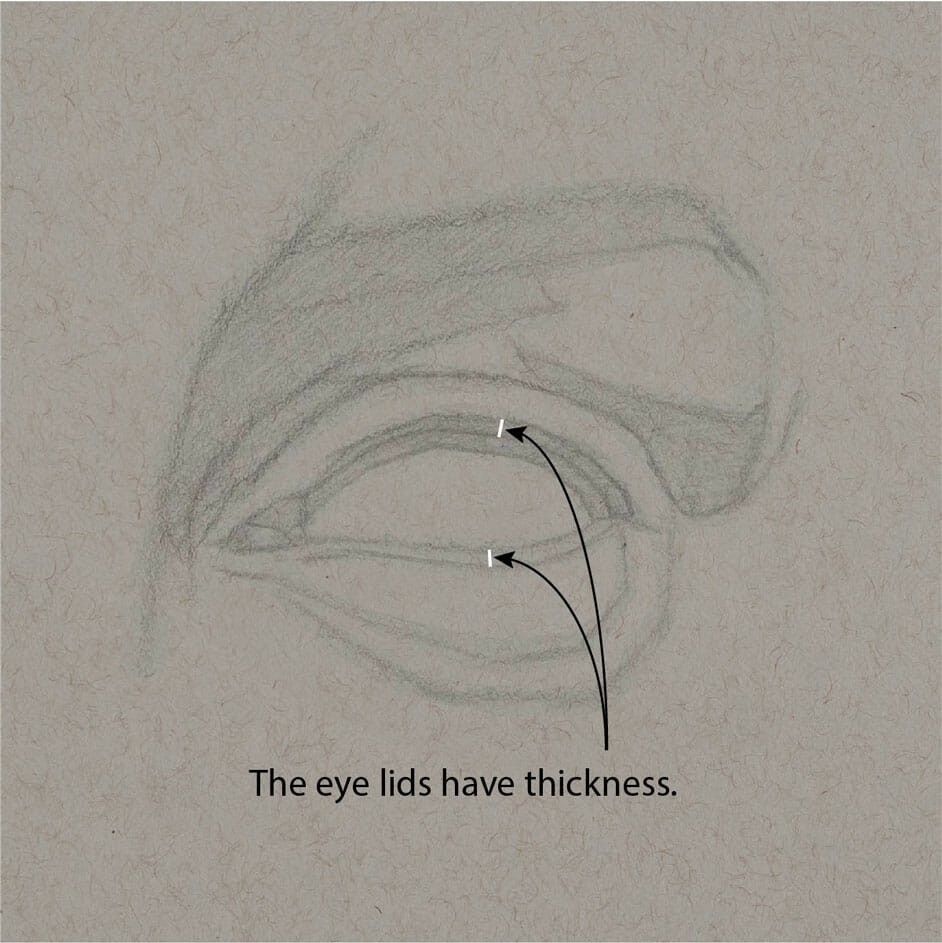
Even in a line drawing, a single line is frequently inadequate for describing the structure of each eyelid. This is because the eyelids have thickness and we tin can frequently see the top or bottom surface of the lids projecting outward from the surface of the eyeball. Including these planes in your drawing will help give your eyes dimension, making the eyeballs appear relatively recessed into the heart sockets – which they are.
3: Adding the Iris and Pupil
With respect to drawing the physical eyeball, there are four components we need to consider:
- The student is basically just a hole in the eyeball allowing for the ingress of light.
- The iris is a pigmented disc that surrounds the pupil, featuring a complicated mechanism that allows the aperture to expand or contract.
- The cornea is a raised, transparent dome-like structure that sits on top of the pupil and iris.
- The sclera comprises the remaining surface of the eyeball and is what we commonly refer to as the "white of the eye"
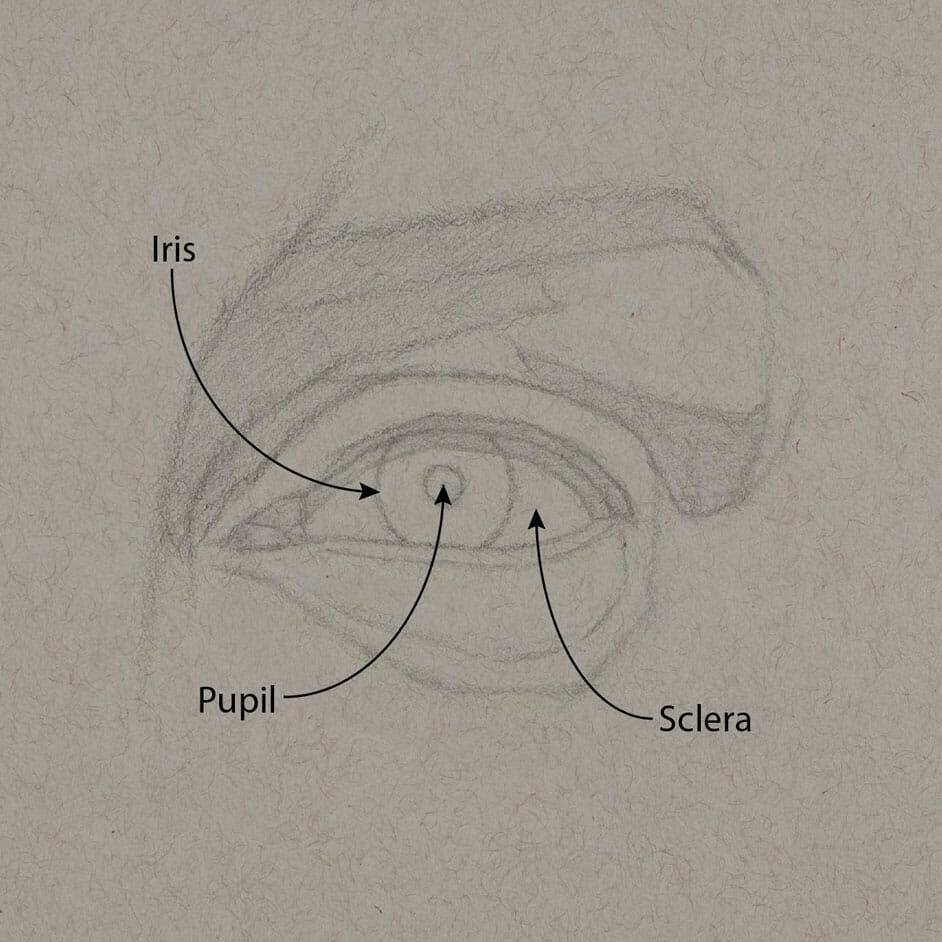
Scale
Students oftentimes struggle with finding the appropriate scale for the iris and pupil. The trend is to describe them too large, filling up also much of the space between the eyelids, which can make a portrait look infantile or like an anime character.
A popular rule of thumb is that the size of the iris is about ⅓ that of the whole eyeball. This is roughly true, but it's likewise tricky to utilize. Nosotros don't see the full width of the eyeball considering much of information technology is covered by the bones and eyelids, so determining ⅓ of that altitude usually involves some estimate work. So keep the thirds rule in mind, but also try to find the proportion of iris to sclera visible on the eye from your indicate of view. If the iris is likewise large on your drawing, the space available for the sclera volition be too small-scale.
Shape
When viewing the eye from the forepart, the iris and student announced round… or at least close. You may occasionally observe on some individuals that these shapes aren't perfectly round, but it's wise to draw them as circles anyhow. Otherwise, it may look similar a weird drawing error.
If the model'due south gaze is turned away from yous, nevertheless, the circles of the iris and student will become elliptical. For a comprehensive procedure for cartoon ellipses correctly, check out our Drawing Basics course!
The Iris is a Calorie-free Saucepan
An of import characteristic of the iris that's often disregarded is that it has depth. The outer rim of the iris sits affluent with the surface of the sclera, but the inner aperture of the pupil is prepare somewhat in. This gives the iris a noticeable "bucket" or "lampshade" structure (or "like the laser canon on the Death Star" as one student aptly put it.) This inverted shape has of import consequences for our light and shade development, as we'll see later.
The Cornea
Covering the iris and student is a transparent dome called the cornea, which assists in focusing light into the eye. Retrieve of the cornea as being like a contact lens sitting on the front of the eyeball. It isn't directly visible because it'south encounter-through, but it'due south influence is: highlights seen on the eyeball often sit down on the cornea, partially obscuring the iris and educatee, considering the cornea projects frontwards.
This forward project of the cornea too has an influence on the shape of the upper eyelid. Depending on the direction of the model's gaze, the lid may go pushed upward and outward over the "bump" of the dome-shaped cornea. This can influence where nosotros perceive the high point of the upper lid to be as it arcs over the eyeball.
And Now The Fun Role: Calorie-free & Shade
With the linear structure established, it'due south time to transition toward light and shade development. This is where we build upon the work we've done to make the eye appear assuredly illuminated and 3-dimensional.
Yous may have already completed (or partially completed) he beginning step toward this goal: drawing the shapes of the shadows. This helps us in the linear phase in getting positions and proportions right, just it'due south also how we begin to point the different orientations of planes on the centre. If nosotros do this right, nosotros can create a rudimentary sense of grade with just ii values: one for the light side and one for the shadow. This binary statement is chosen a "poster".
Think of the light masses and shadow masses as being like puzzle pieces – they should fit together perfectly. The border between these puzzle pieces is what we phone call the "shadow edge" or "terminator". The terminator is what we're going to draw at this stage with a soft line as it bumps over the various forms of the eye region.
Every bit you carve out the shapes of diverse shadows on and around the middle, hatch them down lightly with an HB pencil. This volition aid you see if your shadow shapes are right.
A Note about Lighting:
This is the phase where poor reference textile tin can really crusade you problems. A lot of studio photography uses multiple light sources with large diffusers to fill shadows and make blemishes and wrinkles harder to come across. The consequence tin exist flattering, but it'southward besides flattening. Without any shadows, there's fiddling to tell your brain what planes are oriented in what direction, so creating the illusion of 3-dimensional course in your drawing is nearly incommunicable without lots of invention.
To solve this problem, draw from life when possible. If cartoon from life isn't an option, ever ask yourself this question when choosing a photo reference: "Where is the primary lite source in this picture?". If you can't tell, keep looking for a better photo, or take one yourself!
4: Reference Values
Before outset the full light and shade development on the eye (or on anything), we start need to fix the range of values. This is of import because "light" and "dark" are relative. We can only determine how lite or night something should be in comparison to the lightest light and darkest nighttime. We call these "reference values". I liken the role of these values to that of the oboe when tuning an orchestra – all the music that is to follow is tuned relative to that.
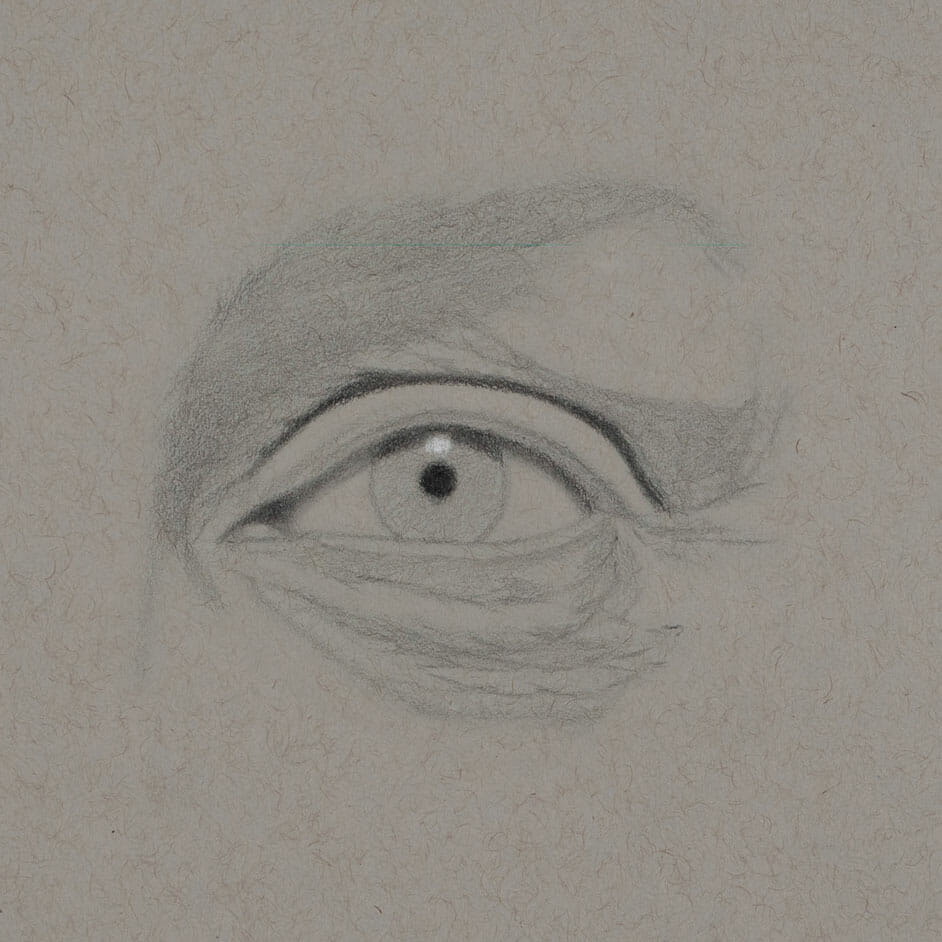
The darkest darks in the eye region are predictably plant in a few places (assuming the light is traveling from to a higher place). The deep crease of the upper lid along the supraorbital margin is one candidate. The pupil of the eye is another (bold information technology's not obscured by any reflections on the cornea).
The lightest lights are usually observed on the up-turned surfaces of either lid, or perchance in a highlight on the cornea or sclera. Highlights are reflections of the light source, later on all, and so they tend to be quite vivid.
5: Tuning "Chords"
With the reference values in place, it's time to begin "tuning" the values of nearby areas, carefully gauging the "interval" between different notes. This can be catchy to exercise well – at least if you lot're new to this idea – but hither are a few tips to help you lot out:
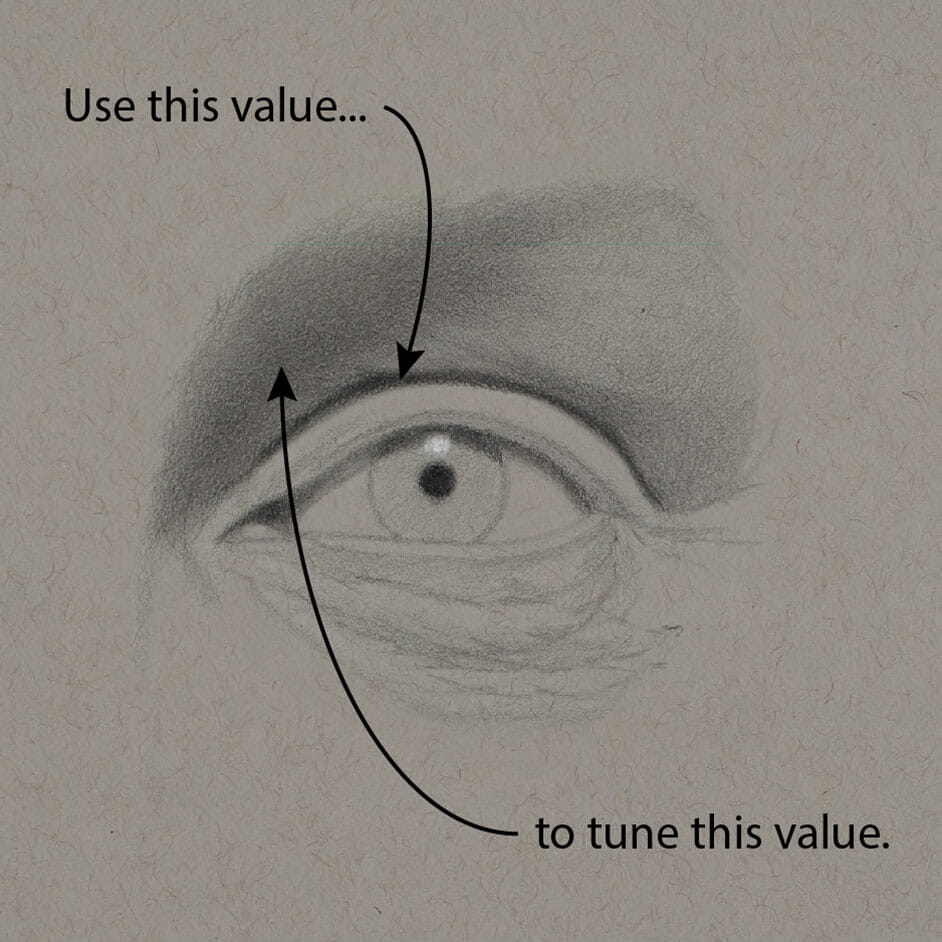
- Work adjacent areas. Don't hop all around your drawing at this phase. Information technology's easier to approximate value relationships when they're right next to each other.
- Melody small intervals first. It'southward easier to gauge small intervals than larger ones. With the darkest dark established, look for the adjacent darkest nearby value and develop that first.
- Work across boundaries. Don't let the names of things confine y'all. If you're working in the iris/pupil surface area, exist sure to develop nearby values on the sclera and the lids, too. Don't endeavor to complete annihilation earlier you lot've integrated it with the surrounding value structure.
vi: Modeling Forms
At this stage, your drawing may resemble a patchwork quilt, with a few clusters of different values tuned to each other. It'southward at present time to begin organizing these flat notes of value into progressions – or gradients – that become darker or lighter as the course turns away from or toward the primary calorie-free source.
Remember that the eyeball is a sphere. The lids follow the curvature of that sphere equally they arc beyond the eye from one corner to the other, meaning the orientation of these surfaces relative to the light source is constantly changing. In order for our cartoon to appear iii-dimensional, it'southward necessary to describe the "turning" of these surfaces with gradual changes in value running in different directions.
To some extent, this can be done visually – but compare your drawing with your reference and attempt to match the value relationships you see. But it's also necessary to consider the direction of the lite. Past this I mean thinking in a three-dimensional way, considering the relative orientation of different planes to the light source. Bold a consistent local value and distance to the light source, surfaces that face the light more directly should be lighter than those the face up the calorie-free less directly. Being enlightened of this can help convey value changes that you may not observe visually – the difference in value between i part of the form and another may be very subtle, but important nonetheless.
A good example of this tin can be seen on the iris. Call up the "saucepan shaped" construction of the iris I referenced before? This has a large influence on the values we use in this area because the planes are inverted. The lightest part of the iris is at the lesser where the surface faces up toward the light, and the darkest function is at the superlative – exactly the opposite of what we run across on the sclera and the eyelids. The orientation of a given surface to the light matters. A lot.
Every bit you develop your values, endeavour to call up about "sculpting" the class every bit you go. This is why nosotros typically refer to this phase as "modeling" rather than "shading". The goal here is to uses gradients and progressions of value to gently "plow" the surface of the grade upwardly toward the light (lighter) or down and away from it (darker). It tin can assist to imagine while drawing that your pencil is a tiny clay tool, pushing and pulling the surface of a petty virtual sculpture that sits behind the picture show airplane. Thinking this way can assistance y'all fine-melody your values, and gratuitous you from the tyranny of merely "copying" what y'all encounter – which usually doesn't produce the all-time results.
vii: Eyelashes, Highlights and Other Details
Once you've developed the major forms on your drawing, you're nearly at the terminate line. What remains is to observe some of the smaller details and describe those likewise, integrating them into the broader value construction you've already established.
But kickoff, I should say that y'all don't actually have to do this. I got a bit ahead of myself and developed some of the wrinkles nether the lower lid already, but you could opt to simplify your drawing by non getting quite so granular. Contrary to popular belief, more "details" isn't always meliorate in realism. Instead, it can result in a expect that's simply too choppy and busy. On the other paw, details tin can be fun to draw, so practice what feels right.
Eyelashes
Groupings
Eyelashes sometimes cause problems for students in a way similar to cartoon hair: we tend to think of them as individual hairs and neglect to notice that hair usually congregates into groups.
Think of it this mode: if you lot were a sculptor, you wouldn't model the hair on a portrait bust by rolling out thousands of lilliputian spaghettis of dirt and calculation them i at a time. Instead, y'all would sculpt the overall shape of the hair mass. The outcome of individual hairs would be a very minor detail, probably saved for the very stop, if you included them at all.
Nosotros should try to handle pilus of any kind in a similar way while drawing, including the eyelashes. Don't describe individual lines for each lash. Instead, try to observe how the lashes group together. Sometimes, if your model is further away, they tin can be seen every bit a unmarried ribbon-like form along the edge of the upper lid. In other cases, such every bit when your model is wearing mascara, the lashes tend to clump together, forming a number of spikey points, like curved daggers, jutting out from the eyelid.
Orientation
Information technology'southward also important to consider the orientation of the eyelashes every bit they protrude from the edge of each chapeau. Remember, the eyeball is curved, and the eyelids along with them. Eyelashes virtually e'er projection outward from the eye, roughly perpendicular to the surface of the eyeball. So, lashes that are ready in the center of the eyelid volition project roughly forwards. Simply every bit the eyelid wraps effectually the eyeball, its surface changes orientation. Approaching the lateral corner of the eye, the lashes volition announced to project somewhat sideways, simply still perpendicular to the surface of the eyeball (or shut).
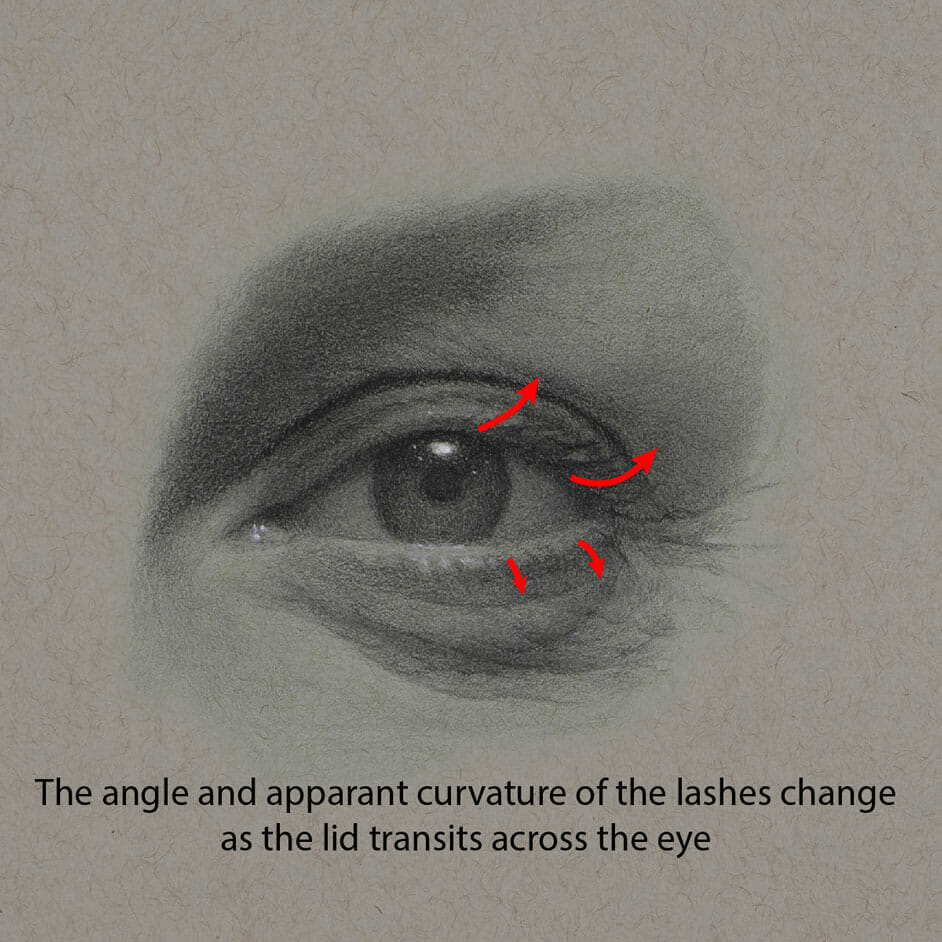
Curvature
Eyelashes are never direct, but curved. The trajectory of the upper lashes projects outward from the bottom edge of the eyelid, but then curves gently up toward the tips. This effect is even more pronounced if your model is wearing mascara or simulated eyelashes, in which case the curved sweep of the lashes will be unmistakeable.
Highlights
Highlights are merely tiny reflections of the low-cal source bounced off the surface of a grade. They're not always clearly visible, only when they are, it's normally on smooth, sleeky surfaces… similar an eyeball.
A highlight will be visible on the eyeball when the incident rays from the light source bounciness off its surface at just the right angle toward the eye of the viewer. In this case, there is a pretty strong highlight just above the pupil. But there are other, smaller, dimmer highlights to exist seen in on the slick surfaces of the inner canthus and along the top of the lower lid where it meets the moisture surface of the eyeball.
Depending on how bright the highlights are, and the value of your paper, you may discover information technology necessary to utilise some white chalk to get the correct value. In this example, because the surrounding value of the iris is so dark, I began by erasing any graphite in the area showtime, and so applied chalk opaquely with a sharp General's Charcoal White pencil. The other, dimmer highlights were also applied with the chalk pencil, but less opaquely.
Other Details
At this point, you lot may be washed drawing the eye. Including surface details like wrinkles and pores in the skin often isn't necessary, and tin fifty-fifty detract from your drawing if they're mishandled.
If you do choose to pursue this level of description, be aware that many of the wrinkles or "crows feet" we encounter around the eye are prepare perpendicular to to the musculus fibers of the Orbicularis Oculi, which travel around the middle region in concentric circles. When these musculus fibers contract, they crusade the the eye to scrunch upward – similar the draw string in a hoodie – causing wrinkles to radiate outward, cutting across their circular path.
The skin under the eye, between the lower lid and the infraorbital furrow, is quite soft and sensitive. It can show variations in color, such as redness or subtle violet tones. As we age, this surface area can as well exist a locus of pocket-size wrinkles as sagging skin collects above the rigid bottom border of the eye socket.
If you choose to draw those wrinkles as I did, just remember that pocket-size features on the skin are forms, but similar the larger ones, and every course has a calorie-free side and a night side. Students frequently go off-target when cartoon wrinkles by focusing likewise much on the grooves in the skin, drawing them equally lines on the page. But it'southward important to remember that most texture we might endeavour to describe – including on the pare – is but an arrangement of peaks and valleys.
Those grooves nosotros meet in wrinkles are depressions in the surface – little ruts and ravines that run between an organization of puckering fullnesses that projection outward, each catching the light in its own mode. These modest but full forms between the wrinkles are what y'all want to focus on, describing the light side and nighttime side of each. Do that within an advisable range of values, and the "wrinkles" volition almost draw themselves.
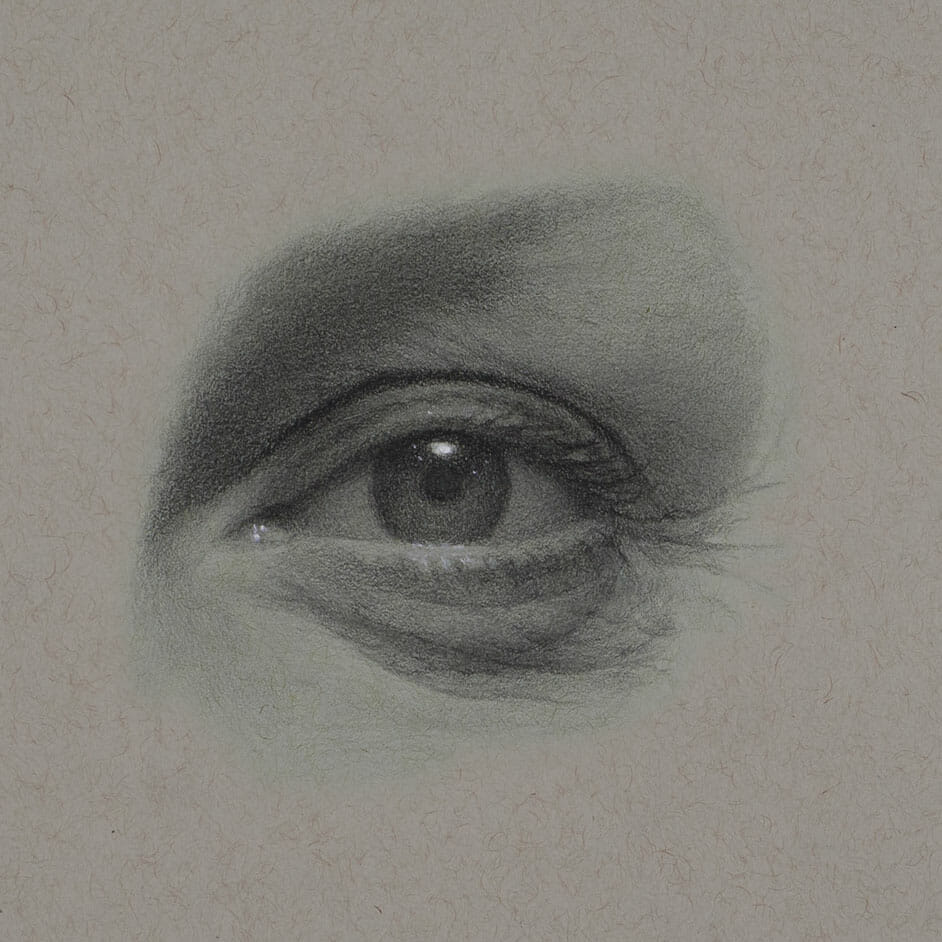
Conclusion
For every bit much information as I've included in this post, it's nevertheless not comprehensive. In that location's a huge diversity of human faces out at that place, and anybody's eyes are a little bit different. Add together to that different perspectives and lighting weather condition, and there is simply no single approach to cartoon optics that is correct or complete.
Ultimately, the all-time fashion to draw improve optics is to draw lots of them – exercise is the key to honing any skill, including drawing. So I hope you notice the data presented hither helpful equally you work to develop your drawing skills.
Source: https://vitruvianstudio.com/how-to-draw-better-eyes/
Posted by: oneallaremas.blogspot.com


0 Response to "How To Draw The Human Face How To Draw The Human Eye"
Post a Comment